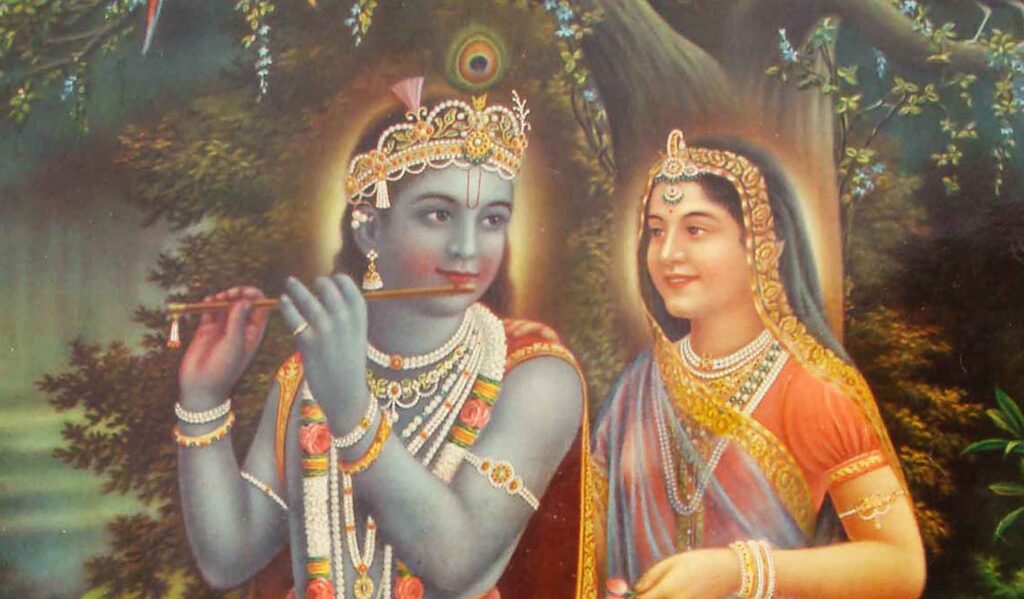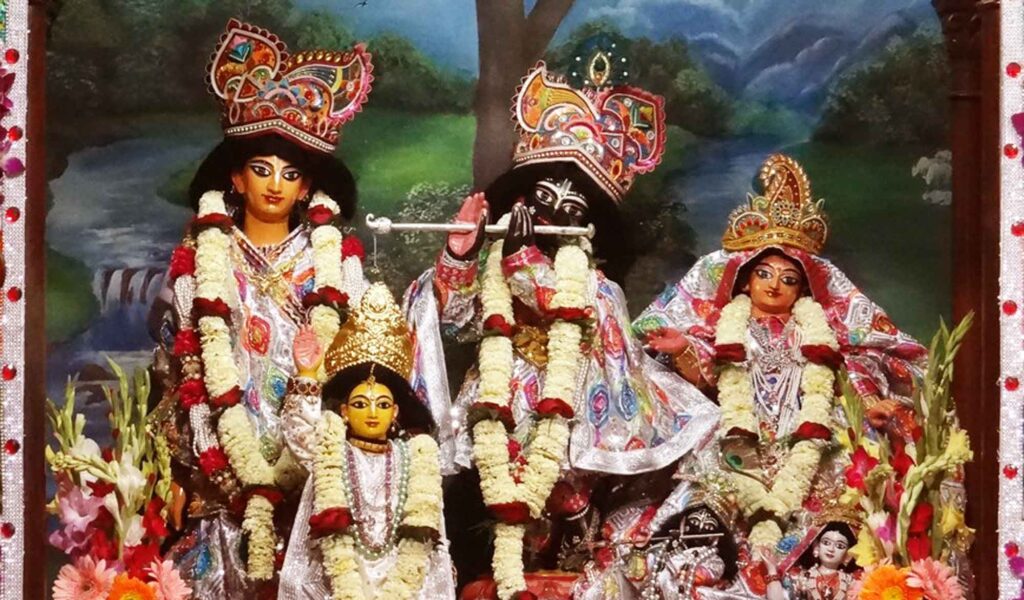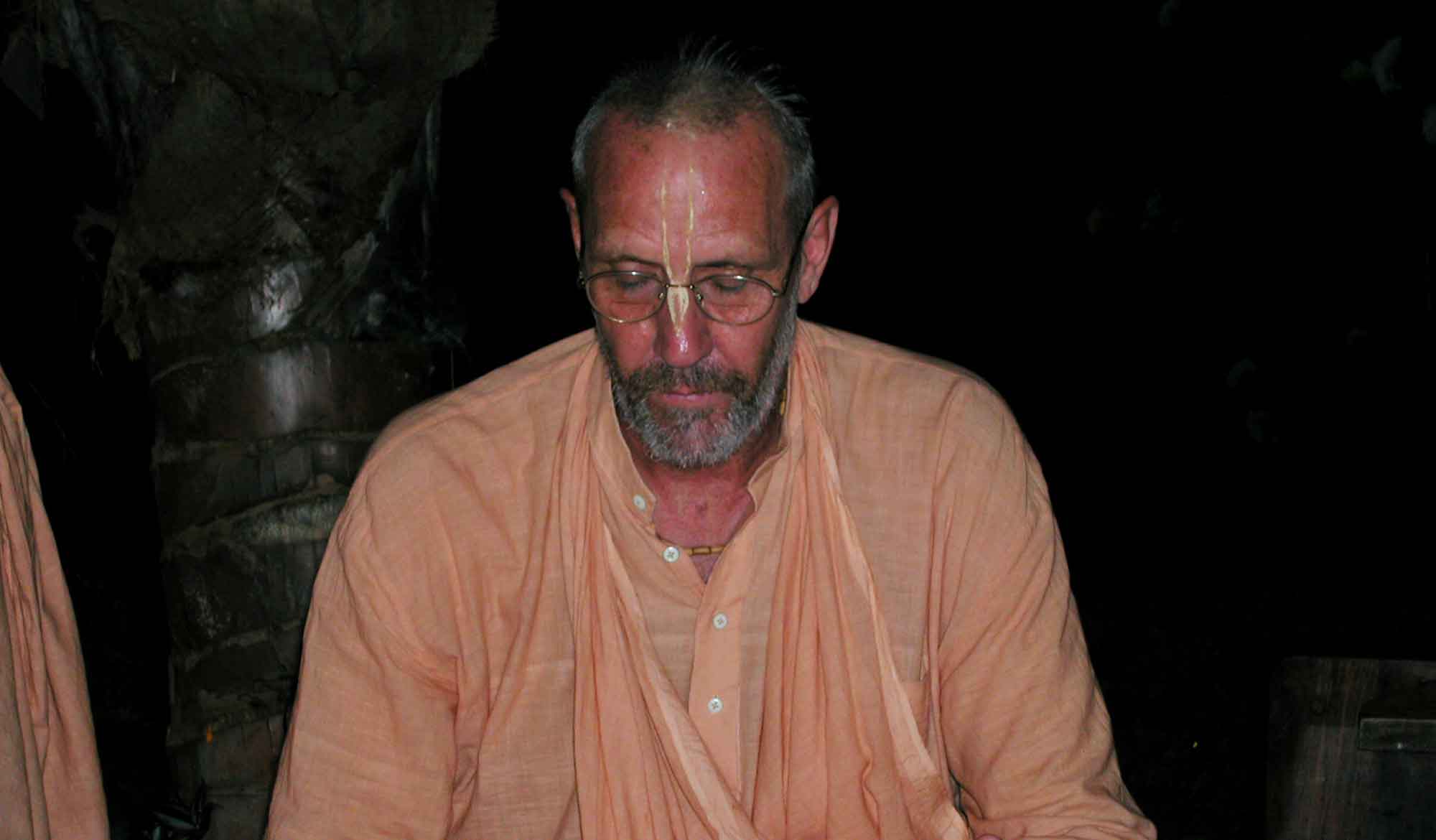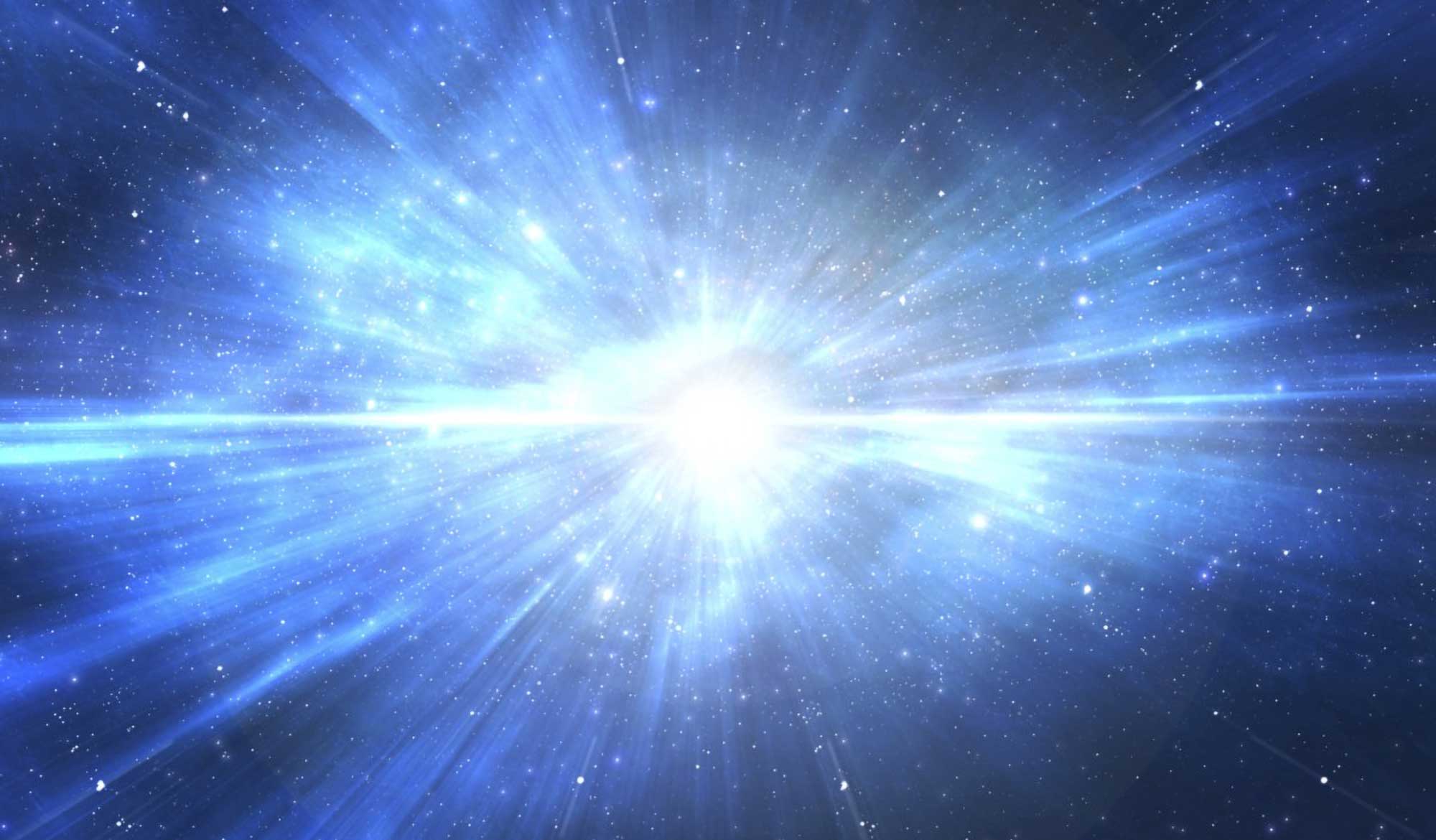by Swami B.G. Narasingha
“Śrī Gaura-Gāyatrī Vijaya - Establishing the Eternality of Śrī Gaura Gāyatrī" was written in 1999 by Śrīla Narasiṅgha Mahārāja to explain the history, significance and importance of the gaura-gāyatrī in the Gauḍīya Vaiṣṇava sampradāya. This article was included in the publication, “Śrī Gāyatrī-Mantrārtha Dīpikā”.
According to the Vedic pramāṇa (śruti, Purāṇas, Mahābhārata, and Śrīmad–Bhāgavatam) Śrī Caitanya is none other than Kṛṣṇa, the Supreme Personality of Godhead, who has descended in Kali-yuga in the guise of a devotee. The Vedic evidences describe the avatāra of the Kali-yuga according to His qualities and characteristics such as His complexion, His dress, His activities; and even His mother’s name is mentioned.
When Kṛṣṇa appears in Kali-yuga He appears as the son of Śacī (the Mother of the universe), He assumes the dress of a sannyāsī and His complexion is the colour of molten gold. He propagates the chanting of kṛṣṇa–nāma as the yuga–dharma (socio-religious-function for the age) and He is accompanied by His friends and associates. This is confirmed in the śruti as follows:
mahān-prabhur vai puruṣaḥ sattvasyeṣa pravarttakaḥ
surnimalām imaṁ śāntīmīśano jyotiravyaḥ
“The Personality of Godhead, Śrī Caitanya Mahāprabhu, is brilliantly effulgent and imperishable like molten gold. He is the Supreme Controller, He controls the mode of goodness and through saṅkīrtana bestows spiritual intelligence on the living beings. In the guise of a sannyāsī, He is the source of spiritual purity and liberation. He is therefore known as “Mahāprabhu”. (Śvetāśvatara Upaniṣad 3.12)
The confirmation that the Lord will appear as the son of Mother Śacī is found in the following verses from the Vāyu Purāṇa and the Brahma–yāmala.
kalau saṅkīrtanārambhe bhaviṣyāmi śacī-sūtaḥ
“In the age of Kali when the saṅkīrtana movement is inaugurated, I shall descend as the son of Śacīdevī.” (Vāyu Purāṇa)
atha vāhaṁ dharādhāme bhūtvā mad-bhakta-rūpa-dhṛk
māyāyām ca bhaviṣyāmi kalau saṅkīrtanāgame
“Sometimes I personally appear on the surface of the world in the garb of a devotee. Specifically, I appear as the son of Śacī in Kali-yuga to start the saṅkīrtana movement.”(Brahma–yāmala)
Even though Kṛṣṇa appears in every yuga, namely Satya, Tretā, Dvārapa, and Kali, He is nonetheless called Triyuga (one who incarnates in three ages), because in Kali-yuga His appearance is hidden. In all other yugas the Lord is easily recognizable but in Kali-yuga He is hidden. That is, in Kali-yuga the Supreme Lord appears in the form and mood of His devotee.
In Śrīmad Bhāgavatam Prahlāda Mahārāja addresses Kṛṣṇa as Triyuga:
dharmaṁ mahā-puruṣa pāsi yugānuvṛttaṁ
channaḥ kalau yad abhavas tri-yugo ‘tha sa tvam
“O Kṛṣṇa, O protector of religious principles, in the age of Kali, You do not assert Yourself as the Supreme Personality of Godhead. Because Your incarnation is hidden in the age of Kali, You are known as Triyuga, or the Lord who manifests His supremacy in only three ages.” (Bhāg. 7.9.38)
In the Caitanya–caritāmṛta we find the following verses composed by the learned scholar Sārvabhauma Bhaṭṭācārya:
vairāgya- vidyā-nija-bhakti- yoga-
śikṣārtham ekaḥ puruṣaḥ purāṅaḥ
śrī-kṛṣṇa-caitantya-śarīra-dhārī
kṛpāmbudhir yas tam ahaṁ prapadye
“Let me take shelter of the Supreme Personality of Godhead, Śrī Kṛṣṇa, who has descended in the form of Śrī Kṛṣṇa Caitanya Mahāprabhu to teach us real knowledge, His devotional service, and detachment from whatever does not foster Kṛṣṇa consciousness. He has descended because He is an ocean of transcendental mercy. Let me surrender unto His lotus feet.” (Cc. Madhya-līlā 6.253)
kālān naṣṭaṁ bhakti-yogaṁ nijaṁ yaḥ
prāduṣkartuṁ kṛṣṇa-caitanya-nāmā
āvirbhūtas tasya pādāravinde
gāḍhaṁ gāḍhaṁ līyatāṁ citta-bhṛṅgaḥ
“Let my consciousness, which is like a honeybee, take shelter of the lotus feet of the Supreme Personality of Godhead, who has just now appeared as Śrī Kṛṣṇa Caitanya Mahāprabhu to teach the ancient system of devotional service to Himself. This system had almost been lost due to the influence of time.” (Cc. Madhya–līlā 6.254)
These verses by Sārvabhauma are perfectly in line with the statements of the revealed scriptures. In every yuga the Supreme Lord descends to establish the principles of religion. This is stated in Bhagavad-gītā as follows:
yadā yadā hi dharmasya glānir bhavati bhārata
abhyutthānam adharmasya tadātmānaṁ sṛjāmy aham
“Whenever and wherever there is a decline in religious practice, O descendant of Bhārata, and a predominant rise of irreligion, at that time I descend Myself.” (Bg. 4.7)
Realization of Śrī Caitanya as the Supreme Personality of Godhead is expressed thus in the Muṇḍaka Upaniṣad:
yadā paśyaḥ paśyate rukma-varṇaṁ
kartāram īsaṁ puruṣaṁ brahma-yonim
tada vidyan punya-pape vidhuya
niranjanah paramam samyam upaiti
“When one realizes the golden form of Śrī Caitanya, who is the ultimate actor and the source of the Supreme Brahman, he attains the highest knowledge. He transcends both pious and impious activities, becomes free from worldly bondage, and enters the divine abode of the Lord.” (Muṇḍaka Upaniṣad 3.3)
Śrīmad Bhāgavatam also confirms that in Kali-yuga Kṛṣṇa will appear to spread the saṅkīrtana movement along with His eternal associates. In the eleventh canto the sage Karabhājana Muni, while describing the avatāras (incarnations) of the four yugas to King Nimi gives the following verse:
kṛṣṇa-varṇaṁ tviṣākṛṣṇaṁ sāṅgopāṅgāstra-pārṣadam
yajñaiḥ saṅkīrtana-prāyair yajanti hi su-medhasaḥ
“In the age of Kali, Kṛṣṇa appears in a golden form, chanting the two syllables kṛṣ–ṇa. He descends along with His weapons, limbs, energies, and eternal confidential associates. Those with intelligence worship Him with the saṅkīrtana yajña.” (Bhāg. 11.5.32)
Here it is being described that the two syllables kṛṣ–ṇa are always in the mouth of the Kali-yuga avatāra. He always describes Kṛṣṇa with great pleasure. These are the two meanings of the words “kṛṣṇa varṇa.” Indeed, nothing but Kṛṣṇa issues from His mouth. If someone tries to describe the Kali-yuga avatāra as blackish then the use of the word tviṣākṛṣṇaṁ immediately restricts him. That the avatāra for Kali-yuga is not blackish indicates that His complexion is golden.
The fact that Kṛṣṇa sometimes appears in a golden colour is also confirmed by the astrologer Garga Muni who performed the name giving ceremony after the appearance of Kṛṣṇa. Garga Muni informed Kṛṣṇa’s father, Nanda Mahārāja, as follows:
āsan varṇās trayo hy asya gṛhṇato ‘nuyugaṁ tanūḥ
śuklo raktastathā pīta idānīṁ kṛṣṇatāṁ gataḥ
“This boy, Kṛṣṇa, has three other colours: white, red, and yellow as He appears in different ages. Now, in this Dvārapa-yuga, He has appeared in a transcendental blackish colour.” (Bhāg. 10.8.13)
In the Viṣṇu–sahasranāma, the book containing one thousand names of Viṣṇu, there is a description of Śrī Caitanya as follows:
suvarṇa-varṇo hemāṇgo varāṅgaś-candanāṅgadī
“Kṛṣṇa appears as Śrī Caitanya Mahāprabhu, and in His early pastimes He appears as a householder with a golden complexion (suvarṇa–varṇa and hemāṅga). His limbs are beautiful (varāṅga), and His body is smeared with the pulp of sandalwood, seems like molten gold (candanāṅgadī).” (Viṣṇu–sahasranāma 92)
In his commentary on Viṣṇu–sahasranāma called the Nāmārtha–sudhābhidha, Śrīla Baladeva Vidyābhūṣaṇa, commenting on this verse, asserts that Śrī Caitanya is the Supreme Absolute Truth according to the evidence of the Upaniṣads. He explains that suvarṇa–varṇo means golden complexion and that the word varāṅga means “exquisitely beautiful.” He also quotes the Vedic injunction yadā paśyaḥ paśyate rukma-varṇaṁ kartāram īśaṁ puruṣaṁ brahma-yonim. Rukma-varṇaṁ kartāram īśaṁ, he says, refers to the Supreme Absolute Truth as the Supreme Person having a complexion the colour of molten gold. Puruṣam means the Supreme Person, and brahma–yonim indicates that He is also the Supreme Brahman. This evidence proves that Śrī Caitanya is the Supreme Personality of Godhead Kṛṣṇa.
In a similar verse the Dāna–dharma, chapter 149 of Mahābhārata also describes the appearance of Kṛṣṇa as Śrī Caitanya:
suvarṇa-varṇo hemāṇgo varāṅgaś-candanāṅgadī
sannyāsa-kṛc chamaḥ śānto niṣṭhā-śānti-parāyaṇaḥ
“When Kṛṣṇa appears as Śrī Caitanya (Śrī Gaurāṅga), in His early pastimes His complexion is golden (suvarṇa–varṇa), His limbs are the colour of molten white gold (hemāṇga), His body is extremely beautiful (varāṅgaś), and He is decorated with sandalwood pulp (candanāṅgadī). He accepts sannyāsa (sannyāsa–kṛt) and shows equanimity (sama). He is peaceful (śānta). His mind is always fixed on Kṛṣṇa and thus He is niṣṭhā, or fixed, in performing the great sacrifice of the holy name of Kṛṣṇa. He silences the non-devotees and impersonalists who are opposed to the service of the Lord by promoting the cause of devotion. Thus He distributes real peace. He is therefore an abode of the highest spiritual peace and devotion.”
Therefore, after consulting various Vedic scriptures the conclusion is that the name, form, attributes, and pastimes of Śrī Caitanya are indeed eternal. The eternality of Śrī Caitanya is further confirmed in the Agni Purāṇa:
aham eva dvija-sreṣṭha nityaṁ pracchana-vigrahaḥ
bhagavad-bhakta-rūpena lokān rakṣāmi sarvadā
“O best of the brāhmaṇas, My distinguished form is eternal. In this way, with My own form hidden from ordinary sight I take the form of a devotee and appear among the people in general in order to establish and protect religious principles.”
Although Śrī Caitanya is the Supreme Personality of Godhead and verifiably so according to the śruti etc., still the smārta–brāhmaṇa community in India strongly opposes the worship of gaura–mantra. They consider gaura-mantra to be a concoction of the modern day sect of Śrī Caitanya.
That this is not so is shown by the following two references which prove that the gaura–mantra was chanted during and even before the time of Śrī Caitanya. In the Caitanya–caritāmṛta we find the incident wherein Nakula Brahmacārī spoke to Śivānanda Sena revealing the worshipable mantra of Śivānanda. Nakula Brahmacārī said:
gaura-gopāla mantra’ tomāra cāri
“You are chanting the gaura–gopāla mantra composed of four syllables.” (C.c. Antya-līlā 2.31)
This gaura–gopāla mantra of four syllables is gau–ra–āṅ–ga as in gaura mantra (klīṁ gaurāya namaḥ). Some Vaiṣṇavas say that gaura–gopāla mantra is rā-dhā kṛṣ–ṇa as in Rādhā-Kṛṣṇa (Rādhā being gaura, golden, and Kṛṣṇa being gopāla, the cowherd boy). Yet other Vaiṣṇavas say that the gaura–gopāla mantra means Śrī Caitanya who is Kṛṣṇa (Gopāla) appearing in a golden colour. Both these opinions are correct due to there being no difference between Rādhā-Kṛṣṇa and Śrī Caitanya – śrī-kṛṣṇa-caitanya rādhā-kṛṣṇa nahe anya. Those who chant the name of Gaurāṅga and those who chant the names of Rādhā-Kṛṣṇa are on the same level.
The second reference proving that gaura–mantra was chanted even before the appearance of Śrī Caitanya is found in the Ūrddhvāmnāya–saṁhitā wherein Vyāsa answers the inquiry of Nārada Muni as to which mantra is used in the worship of Bhagavān Śrī Gaurāṅga (Śrī Caitanya). Vyāsa replied;
klīṁ gaurāya namaḥ iti sarva-lokeśu pūjitaḥ
mayā-ramānāṅga-bījaiḥ vāg-bījena ca pūjitaḥ
sadasaraḥ kirtito `yaṁ mantra-rājaḥ sura-drumāḥ
mantro tataḥ-klīṁ gaurāyaḥ namaḥ;
hrīṁ, śrīṁ, klīṁ, aiṁ gaurāya namaḥ
“This gaura–mantra (gaurāya namaḥ) is worshiped using the bīja mantras of Māyā, Ramā, Anaṅga, and Sarasvatī. For example, just as we say klīṁ gaurāya namaḥ, similarly we may also say hrīṁ gaurāya namaḥ, śriṁ gaurāya namaḥ, etc. In this way, this six syllable mantra is honoured. When people of the world combine gaurāya namaḥ with kāma–bīja and chant klīṁ gaurāya namaḥ, they receive the gift of divine love. I have chanted to you this ṣaḍākṣara-mantra-bīja, which is like a kalpa–druma because it fulfils all one’s desires.” (Ūrddhvamnaya–saṁhitā 3.16)
Thus the Gauḍīyas chant the gaura–mantra and gaura–gāyatrī preceded by the kāma–bīja as follows:
klīṁ gaurāya namaḥ
klīṁ caitanyāya vidmahe
viśvambharāya dhīmahi
tan no gauraḥ pracodayāt
“I worship Śrī Gaurāṅga (Śrī Caitanya) who is the abode of kṛṣṇa–prema and who is the bestower of that divine love upon the living entities. Let us always remember Śrī Kṛṣṇa Caitanya, the maintainer of the universe, who maintains His pure devotees by sprinkling the drops of nectar upon them, who is Kṛṣṇa within, whose mood and complexion is like that of Śrī Rādhā and who enthuses our capacity of devotional service. As He so enthuses us let us meditate upon Him.”
Vīdmahe means, let us try to know or to concentrate upon Śrī Kṛṣṇa Caitanya. The word viśvambhara stems from the verbal root “dubhṛn” which indicates nourishing and maintaining. Tan no gauraḥ pracodayāt means (gauraḥ — Śrī Caitanya) who enthuses our meditation (dhīmahi). That the gaura–gāyatrī is preceded by the word “klīṁ” meaning the seed of divine love, indicates that Śrī Kṛṣṇa Caitanya nourishes and maintains the three worlds by distributing love of God. One who chants this gāyatrī will surely receive the gift of divine love.
It is also observed that, following the rule of Sanskrit grammar found in the book Varṇāgama–bhāsvadi, the letter “ya”, when followed by the letter “vi” is considered to be a half syallable — the gaura–gāyatrī is thus composed of twenty-three and one half syllables. The kāma gāyatrī (kāmadevaya vidmahe puṣpabanāya dhīmahi tan no `nangah pracodayāt), which is taken to be non-different from Śrī Kṛṣṇa, replete with the pastimes of mādhurya–rasa, is composed of twenty-four and one half syllables following the same rule of grammar. Thus the kāma–gāyatrī and the gaura–gāyatrī are identical in that they awaken divine love of God. We find only one difference between these two mantras and that being the one syllable which is extra in kāma–gāyatrī.
When the two syllables kṛṣ–ṇa are added to the beginning of gaura–gāyatrī (as is the case of those in the disciplic succession of the renowned ācārya and bhakti–rakṣaka—the guardian of devotion, Śrīla Śrīdhara Deva Gosvāmī Mahārāja, it surpasses the kāma–gāyatrī in that it is completed in twenty-five and one half syllables (kṛṣṇa caitanyāya vidmahe viśvambharāya dhīmahi tan no gauraḥ pracodayāt). This additional one syllable, which appears after gaura–gāyatrī has been reconstructed, may thus be taken to represent the magniminity of Śrī Caitanya. Kāma–gāyatrī is kṛṣṇa–līlā — mādhurya–rasa. Mādhurya means that which is sweetest. When magnanimity is added to mādhurya it is called audarya. Audarya–līlā means the wholesale distribution of the mellow sweetness of conjugal love (mādhurya–rasa). This is the sublime characteristic of gaura–gāyatrī and Śrī Caitanya.
namo mahā-vadānyāya kṛṣṇa-prema-pradāya te
kṛṣṇāya kṛṣṇa-caitanya-nāmne gaura-tviṣe namaḥ
“O most munificent incarnation. You are Kṛṣṇa Himself appearing as Śrī Kṛṣṇa Caitanya Mahāprabhu. You have assumed the golden colour of Śrīmati Rādhārāṇī, and You are widely distributing pure love of Kṛṣṇa (kṛṣṇa–prema). We offer our respectful obeisances unto You.” (C.c. Madhya–līlā 19.53)
The use of the word dhīmahi in the gaura–gāyatrī meaning “Let us meditate upon” is also significant. Dhīmahi appears here in the plural which is generally taken to advocate worship or devotion. And how is Śrī Caitanya worshiped in Kali-yuga? Śrīmad–Bhāgavatam, 11.5.32 says, yajñaiḥ saṅkīrtana–prāyair, that He is worshiped by the performance of the saṅkīrtana yajña or the congregational chanting of the holy name. This is the method of worship to be adopted by all classes of intelligent men and women, yajanti hi su–medhasaḥ.
If someone suggests that dhīmahi cannot be taken as such, we point to the ontology of brahma–gāyatrī and Śrīmad Bhāgavatam. Brahma–gāyatrī says dhīmahi, and Śrīmad Bhāgavatam also says dhīmahi in its opening and closing stanzas. This is an advocacy that the brahma-gāyatrī is explained in Śrīmad Bhāgavatam (the purport of gāyatrī), and Śrīmad Bhāgavatam’s final verse recommends saṅkīrtana:
nāma-saṅkīrtanam yasya sarva-pāpa-praṇāśanam
praṇāmo duḥka-śamanas taṁ namāmi hariṁ param
“I offer my respectful obeisances unto the Supreme Lord, Hari, the congregational chanting of whose holy names destroys all sinful reactions, and the offering of obeisances unto whom relieves all material suffering.” (Bhāg. 12.13.23)
Śrīla Śrīdhara Deva Gosvāmī Mahārāja has said in commenting on this verse:
“Pāpa means all anomalies, all undesirable things; in one word, sin. Material enjoyment and liberation are also included as anomalies; sinful activities. Why is liberation considered sinful? Because it is an abnormal condition. Our natural function is to serve Kṛṣṇa, but we do not do that in salvation. Mere salvation does not include service to Kṛṣṇa, so that is an abnormal position and therefore it is also a sin. To ignore our natural duty and stand aloof cannot but be sinful. The concluding verse of the Śrīmad Bhāgavatam says, “Kṛṣṇa’s holy name can relieve us from all undesirable sinfulness, all filthy characteristics and all miseries. Let us bow down to Him.’ Uttering this verse, the Śrīmad Bhāgavatam stops; that great treatise becomes silent. The last word in the Śrīmad Bhāgavatam is nāma–saṅkīrtana. The Śrīmad Bhāgavatam has given such great importance to chanting the holy name of Kṛṣṇa, and Śrī Caitanya developed it from there. Śrīla Vyāsadeva, the compiler of Vedic literature, in his last publication took theism to that stage, and gave it to the public announcing, ‘Chant the name of Kṛṣṇa! Do this, nothing more is necessary. Take this!’ This is the very conclusion of Śrīmad Bhāgavatam, the greatest spiritual gift of Vyāsadeva: ‘Chant the holy name of Kṛṣṇa and begin your life in this dark age with the most broad and wide theistic conception.”
Thus the conception that the gaura–gāyatrī advocates saṅkīrtana, the congregational chanting of the holy name — taking us beyond liberation to the divine life of service, is by all means bona fide. Saṅkīrtana as the most effective method of worship in Kali-yuga is also supported in the following verses:
kṛṣṇa-varṇaṁ tviṣākṛṣṇaṁ sāṅgopāṅgāstra-pārṣadam
yajñaiḥ saṅkīrtana-prāyair yajanti hi su-medhasaḥ
“In this age of Kali those who are intelligent perform the congregational chanting of the Hare Kṛṣṇa mahā–mantra, worshipping the Supreme Personality of Godhead, who appears in this age along with His associates to inaugurate the saṅkīrtana movement, or chanting of the holy names. That incarnation is yellowish in hue.” (Bhāg. 11.5.32)
harer nāma harer nāma harer nāmaiva kevalam
kalau nāsty eva nāsty eva nāsty eva gatir anyathā
“In this age of quarrel and hypocrisy the only means of deliverance is chanting the holy name of the Lord. There is no other way. There is no other way. There is no other way.” (Bṛhad-nāradīya Purāṇa)
kaler doṣa-nidhe rājan asti hy eko mahān guṇaḥ
kīrtanād eva kṛṣṇasya mukta-saṅgaḥ paraṁ vrajet
“My dear King, although Kali-yuga is an ocean of faults, there is still one good quality about this age: Simply by chanting the Hare Kṛṣṇa mahā–mantra (saṅkīrtana) one can become free from material bondage and be promoted to the transcendental kingdom.” (Bhāg. 12.3.51)
krte yad dhyāyato viṣṇuṁ tretāyāṁ yajato makhaiḥ
dvāpare paricaryāyām kalau tad dhari-kīrtanāt
“Whatever result was obtained in Satya-yuga by meditating on Viṣṇu, in Tretā-yuga by performing sacrifices, and in Dvāpara-yuga by serving the Lord’s lotus feet can be obtained in Kali-yuga simply by chanting the Hare Kṛṣṇa mahā–mantra.” (Bhāg. 12.3.52)
kali-kāle nāma-rūpe kṛṣṇa-avatāra
nāma haite haya sarva-jagat-nistāra
“In this age of Kali, the holy name of the Lord, the Hare Kṛṣṇa mahā–mantra, is the incarnation of Lord Kṛṣṇa. Simply by chanting the holy name, one associates with the Lord directly. Anyone who does this is certainly delivered.” (C.c. Ādi–līlā 17.22)
kaliṁ sabhājayanty āyā guṇa-jñāḥ sāra-bhāginaḥ
yatra saṅkīrtanaenaiva sarva-svārtho ’bhilabhyate
“Those who are advanced and highly qualified and are interested in the essence of life, know the good qualities of Kali-yuga. Such people worship the age of Kali because in this age, simply by chanting the Hare Kṛṣṇa mahā–mantra, one can advance in spiritual knowledge and attain life’s goal.” (Bhāg. 11.5.36)
dvāparīyair janair viṣṇuḥ pañcarātrais tu kevalaiḥ
kalau tu nāma-mātreṇa pūjyate bhagavān hariḥ
“In the Dvārpara-yuga people should worship Lord Viṣṇu only by the regulative principles of the Nārada–pāñcarātra and other such authorized books. In the age of Kali, however, people should simply chant the holy names of the Supreme Personality of Godhead.” (Nārāyaṇa–saṁhitā)
yuga-dharma pravartāimu nāma-saṅkīrtana
cāri bhāva-bhakti diyā nācāmu bhuvana
“I shall personally inaugurate the religion of the age — nāma–saṅkīrtana, the congregational chanting of the holy name. I shall make the world dance in ecstasy, realizing the four mellows of loving devotional service.” (C.c. Ādi–līlā 3.19)
Śrī Caitanya is Kṛṣṇa, the maintainer of the universe (viśvambhara), and He has appeared to show us how to perform saṅkīrtana. His mood is just like that of a devotee — not just any devotee, but He appears in the mood of His topmost devotee, Śrīmatī Rādhārāṇī.
rādhā kṛṣṇa-praṇaya-vikṛtir hlādinī śaktir asmād
ekātmānāv api bhuvi purā deha-bhedaṁ gatau tau
caitanyākhyaṁ prakaṭam adhunā tad-dvayaṁ caikyam āptaṁ
rādhā-bhāva-dyuti-suvalitaṁ naumi kṛṣṇa-svarūpam
śrī-rādhāyaḥ praṇaya-mahimā kīdṛśo vānayaivā-
svādyo yenābhūta-madhurimā kīdṛśo vā madīyaḥ
saukhyam cāsya mad-anubhavataḥ kīdṛśam veti lobhāt
tad-bhāvāḍhyaḥ samajani śacī-garbha-sindhau harīnduḥ
“The loving affairs of Śrī Śrī Rādhā-Kṛṣṇa are transcendental manifestations of the Lord’s internal pleasure-giving potency (hlādinī). Although Rādhā and Kṛṣṇa are one in Their identity, They separate Themselves eternally. Now these two transcendental identities have again united in the form of Śrī Kṛṣṇa Caitanya. I bow down to Him who has manifested Himself with the sentiment and complexion of Śrīmatī Rādhārāṇī although He is Kṛṣṇa Himself.
“Desiring to understand the glory of Rādhārāṇī’s love, the wonderful qualities in Him that She alone relishes through Her love for Him, and the happiness She feels when She realizes the sweetness of His love, the Supreme Lord Hari, richly endowed with Her emotions, appears from the womb of Śrīmatī Śacī-devī, as the moon appears from the ocean.” (C.c. Ādi-līlā 1.5-6)
Based on all the above evidences that the identity of Śrī Caitanya is non-different from that of Kṛṣṇa (Śrī Śrī Rādhā-Kṛṣṇa), it has also been recognized that brahma–gāyatrī (oṁ bhūr bhuvaḥ svaḥ tat savitur vareṇyaṁ bhargo devasya dhīmahi dhiyo yo naḥ pracodayāt oṁ) indicates the worship of Śrī Caitanya.
The word savitur of brahma–gāyatrī is taken as indicative of the personality to whom the brahma–gāyatrī ultimately refers. In his purport to Caitanya–caritāmṛta, Madhya–līlā 8.265, Śrīla A.C. Bhaktivedānta Swāmī Prabhupāda explains that savitur means the source of all intelligence (savitri). Ultimately that “savitri”, he says, is Śrī Caitanya because as the Supreme Godhead, Śrī Caitanya is the source of all intelligence in the universe. Furthermore, it is also said that Śrī Caitanya is the original source of the brahma–gāyatrī because of His non-dual identity with Kṛṣṇa. We find no difference between Kṛṣṇa and Śrī Caitanya except that the later has the characteristic of audarya (magnanimity) added to the characteristic of mādhurya (sweetness). The personified essence of such magnanimity is Śrīmatī Rādhārānī.
The Śrīmad Bhāgavatam has been explained by Śrīpāda Jīva Gosvāmī as the purport on brahma–gāyatrī. According to the ācārya the first verse of Śrīmad Bhāgavatam states that the topmost servitor of Kṛṣṇa is Śrīmatī Rādhārānī, and meditation on Her is the subject of dhīmahi. Śrīla Bhaktisiddhānta Sarasvatī Ṭhākura has given a similar purport on the first stanza of Śrīmad Bhāgavatam. He reveals that the Bhāgavatam begins by announcing the appearance of Śrī Caitanya, the Supreme Personality of Godhead.
In the Caitanya–caritāmṛta, Rāmānanda Rāya confirms that indeed Śrī Caitanya is non-different from that very Nārāyaṇa (Viṣṇu) who enlightened Brahmā from within the heart:
eta tattva mora citte kaile prakāśana
brahmāke veda yena paḍāila nārāyaṇa
antaryāmī īsvarera ei rīti haye
bāhire nā kahe, vastu prakāśe hṛdaye
“You (Lord Caitanya) have manifested many transcendental truths in my heart. This is exactly the way Nārāyaṇa educated Lord Brahmā. The Supersoul within everyone’s heart speaks not externally but from within. He instructs the devotees in all respects, and that is His way of instruction.” (C.c. Madhya-līlā 8.264-5)
Śrīmad Bhāgavatam also confirms that brahma–gāyatrī is a meditation on Śrī Caitanya. After the verse following the verse kṛṣṇa-varṇaṁ tviṣākṛṣṇam we find:
dhyeyaṁ sadā paribhava-ghnam abhīṣṭa-dohaṁ
tīrthāspadaṁ śiva-viriñci-nutaṁ śaraṇyam
bhṛtyārti-haṁ praṇata-pāla bhavābdhi-potaṁ
vande mahā-puruṣa te caraṇāravindam
“O Mahāprabhu, Your lotus feet are the highest object of meditation, for they not only destroy the pain of material existence, but they bestow the greatest fulfilment to all souls who take shelter beneath them. Your lotus feet even purify all saintly persons and holy places. Lord Śiva and Lord Brahmā aspire to take shelter beneath Your lotus feet. O Mahāprabhu, You give shelter to all who simply bow down before You. You relieve all the miseries of Your surrendered servants. In the grand ship of Your lotus feet, we can cross over this ocean of material miseries. O Mahāprabhu, I bow down before Your lotus feet.” (Bhāg. 11.5.33)
It is also the opinion of our ācārya, Śrīla Bhaktisiddhānta Sarasvatī Ṭhākura, that this verse directly indicates Śrī Caitanya in that the word mahā–puruṣa means Mahāprabhu Śrī Caitanya, and the word dhyeyaṁ means dhīmahi, which directly indicates the brahma–gāyatrī. The opinion of Śrīla Sarasvatī Ṭhākura regarding Śrī Caitanya as being the hidden subject of Śrīmad Bhāgavatam and brahma–gāyatrī, is also supported by previous ācāryas such as Viśvanātha Cakravartī Ṭhākura.
In the following verse from the Śrīmad Bhāgavatam, the revered Viśvanātha Cakravartī Ṭhākura also draws the subject to Śrī Caitanya, whereas the generally accepted explanation is that the verse applies to Lord Rāmacandra. This opinion is further supported by the fact that this verse directly follows the two verses kṛṣṇa-varṇaṁ tviṣākṛṣṇam and dhyeyaṁ sadā paribhava-ghnam abhīṣṭa-dohaṁ, which clearly refer to Śrī Caitanya Mahāprabhu.
tyaktvā su-dustyaja-surepsita-rājya-lakṣmīṁ
dharmiṣṭha ārya-vacasā yad agād araṇyam
māyā-mṛgaṁ dayitayepsitam anvadhāvad
vande mahā-puruṣa te caraṇāravindam
“O Mahāprabhu, You gave up the Goddess of Fortune and Her great opulence, which is most difficult to abandon, and is sought after even by the Gods. In order to perfectly establish the principles of religion, You left for the forest to honour the brāḥmaṇa’s curse. To deliver the sinful souls who chase illusory pleasures, You search after them and award them Your devotional service. At the same time, You are engaged in search of Yourself, in search for Śrī Kṛṣṇa, Reality the Beautiful.” (Bhāg. 11.5.34)
Viśvanātha Cakravartī Ṭhākura says, “Tyaktvā su-dustyaja-surepsita-rājya-lakṣmīṁ means He left imperial prosperity which is hard to abandon. Generally, this is found in the case of Lord Rāmacandra, but here surepsita-rājya-lakṣmiṁ means the valuable devotional company of Viṣṇupriyā-devī. To the casual observer this may not appear materially substantial, but the dedication that Viṣṇupriyā has shown in Her heart for Śrī Caitanya Mahāprabhu is greater than any imperial standard. And Mahāprabhu had to leave that behind. Such a standard of sacrifice and service is never found even among the great society of the Gods. For the sake of the public welfare, Śrī Caitanya had to ignore the serving, loving attitude of Viṣṇupriyā”
Thus, in this essay we have established the eternality of gaura–mantra and gaura–gāyatrī, with references to the revealed scriptures. In so doing we have also shown that Śrīmad Bhāgavatam and the brahma–gāyatrī are also a meditation on Śrī Caitanya. Gaura Haribol! Gaura Haribol!
More Articles by Swami B.G. Narasingha
The Sacred River Sindhu/Indus
‘The Sacred River Sindhu/Indus’ was posted by Swami B.G. Narasingha on his blog, narasingha.net, on October 2nd, 2011. In this short article, Narasingha Maharaja explains the significance of the River Sindhu and his pilgrimage to it. This article was later expanded into a bigger article called ‘Sindhu River – How India Got Her Name.’
Instructing the Guru
This article “Instructing the Guru” was written in April 2018 by Śrīla Narasingha Mahārāja who answers a question concerning a previous article wherein a Vaiṣṇavī writes a letter to her dīkṣā-guru and explains to him about the importance of śikṣā. In response, a question was raised by a devotee about the etiquette of a disciple instructing her guru.
The Atomic Ray – From Uniform Consciousness to Individual Conscious Units
In “The Atomic Ray - From Uniform Consciousness to Individual Conscious Units” written in 1996 Śrīla Narasiṅgha Mahārāja discusses the constitutional position of the jīva, according to Bhaktivinoda Ṭhākura and Śrī Caitanya-caritāmṛta.













